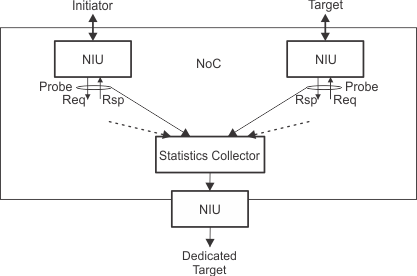SPRAC21A June 2016 – June 2019 OMAP-L132 , OMAP-L138 , TDA2E , TDA2EG-17 , TDA2HF , TDA2HG , TDA2HV , TDA2LF , TDA2P-ABZ , TDA2P-ACD , TDA2SA , TDA2SG , TDA2SX , TDA3LA , TDA3LX , TDA3MA , TDA3MD , TDA3MV
-
TDA2xx and TDA2ex Performance
- Trademarks
- 1 SoC Overview
- 2 Cortex-A15
- 3 System Enhanced Direct Memory Access (System EDMA)
- 4 DSP Subsystem EDMA
- 5 Embedded Vision Engine (EVE) Subsystem EDMA
- 6 DSP CPU
- 7 Cortex-M4 (IPU)
- 8 USB IP
- 9 PCIe IP
- 10 IVA-HD IP
- 11 MMC IP
- 12 SATA IP
- 13 GMAC IP
- 14 GPMC IP
- 15 QSPI IP
- 16 Standard Benchmarks
- 17
Error Checking and Correction (ECC)
- 17.1 OCMC ECC Programming
- 17.2 EMIF ECC Programming
- 17.3 EMIF ECC Programming to Starterware Code Mapping
- 17.4 Careabouts of Using EMIF ECC
- 17.5 Impact of ECC on Performance
- 18 DDR3 Interleaved vs Non-Interleaved
- 19 DDR3 vs DDR2 Performance
- 20 Boot Time Profile
- 21 L3 Statistics Collector Programming Model
- 22 Reference
- Revision History
1.7.2 L3 Statistic Collectors
The interconnect in TDA2xx and TDA2ex has a special component called statistics collector, see Figure 8, that computes traffic statistics within a user-defined window and periodically reports the results in a memory-mapped register or DEBUGSS interface. TDA2xx and TDA2ex has 10 statistic collectors and are dedicated for load/latency monitoring.
 Figure 8. L3 Statistic Collectors Basic Infrastructure
Figure 8. L3 Statistic Collectors Basic Infrastructure The key features of the statistic collector are:
- Nonintrusive monitoring
- Programmable filters and counters
- Collects results at a programmable time interval
Event detectors are programmed through the L3_STCOL_REQEVT and L3_STCOL_RSPEVT configuration registers for request and response ports, respectively. The following events can be identified:
- Word transfer
- WAIT cycles
- Flow control
- Payload transfers
- Latency measurements
Performance monitoring is enabled through the L3_STCOL_EN register. The L3_STCOL_SOFTEN register enables software to monitor the performance. Event muxes are programmed through the L3_STCOL_EVTMUX_SEL0 configuration register that determines which port will be monitored by a filter configured by the filter registers.
Filters are programmed through the L3_STCOL_FILTER_i_GLOBALEN configuration register, along with additional selection criteria programmed through the mask and match registers. A filter can be configured to accept or reject:
- Read operations
- Write operations
- Errors
- Addresses
Filter operation is programmed through the L3_STCOL_OP registers.
There are ten statistic collectors used to monitor the traffic on DRAM (EMIF1, EMIF2, MA_MPU_P1 and MA_MPU_P2), MPU, MMU, TPTC, VIP, VPE, EVE Subsystem, DSP MDMA/EDMA, IVA, GPU, BB2D, DSS, IPU, OCMC RAM, USB, PCIe Subsystem, DSP CFG, MMC, SATA, VCP, GPMC, and McASP ports.
The L3 statistic collectors provide a more accurate measurement of the bandwidth of different initiators. This provides a very good visualization of peaks in the traffic profile of different initiators in the system.
The formulas and concepts for bandwidth measurement when source and destination memories are the same is described in Section 1.7.1.
Bandwidth profiles can be captured using L3 statistic collectors through software executing on the target by using the following steps:
- Capture the number of bytes transferred every ‘x’ µs at the initiator ports (read + write) or the destination memory.
- Use a timer to maintain ‘x’ µs time gap.
- The number of bytes obtained is divided by ‘x’ µs to get the average BW within the ‘x’ µs.
- The process is repeated multiple times to generate a bandwidth profile.
As an example of this measurement technique, the DSS bandwidth profile is captured using x = 100 µs as shown in Figure 9.
As can be seen in Figure 9, with the bandwidth profile you can clearly see the peak bandwidth that corresponds to the DSS pre-fetch period at the beginning of the frame, the gaps in the profile that correspond to the period DSS is displaying data from internal buffers and not requesting for new data. The steady-state bandwidth corresponds to the real-time traffic.
 Figure 9. DSS Single VID-Single VENC 720×480 70 fps RGB
Figure 9. DSS Single VID-Single VENC 720×480 70 fps RGB